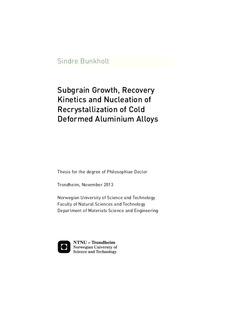| dc.contributor.author | Bunkholt, Sindre | nb_NO |
| dc.date.accessioned | 2014-12-19T13:27:49Z | |
| dc.date.available | 2014-12-19T13:27:49Z | |
| dc.date.created | 2013-12-18 | nb_NO |
| dc.date.issued | 2013 | nb_NO |
| dc.identifier | 680560 | nb_NO |
| dc.identifier.isbn | 978-82-471-4799-3 (printed ver.) | nb_NO |
| dc.identifier.isbn | 978-82-471-4800-6 (electronic ver.) | nb_NO |
| dc.identifier.uri | http://hdl.handle.net/11250/249429 | |
| dc.description.abstract | Phenomena related to annealing of aluminium alloys are among the least understood in aluminium metallurgy but very important for industrial thermo-mechanical processing i.e. deformation and annealing. Physical models are used to predict recovery and recrystallization behaviour, and associated material properties, industrially. However, alloy development, e.g. to incorporate more recycled aluminium, has shown that current softening models are not satisfactory. Thus, improvements do require a better understanding and quantitative description of these phenomena.
In this PhD work, subgrain growth has been studied by EBSD in cold rolled high and commercial purity aluminium alloys with emphasis on the subgrain growth behaviour of individual texture components (orientation dependent). The growth mechanisms do not appear particularly alloy dependent but coarsening is dissimilar in differently oriented subgrain structures. In the Cube and Goss texture components, growth is particularly fast after an incubation time, which is not observed in the Cu, S or Brass components. However, the local orientation gradients appear to be more important for the growth mechanism than the actual orientations. Typically, there are large orientation gradients and the boundary misorientations are increasing during annealing. However, in both S and Brass, decreasing misorientations were observed when the local orientation gradients were < 0.5°/µm, suggesting another growth mechanism.
Subgrain sizes and misorientations were successfully characterized using a novel method developed within this PhD work, utilizing commercial EBSD and photo editing software.
In addition, the effect of interannealing on softening and recrystallization was investigated in the commercial purity alloy and comprehensively described. In literature there is some uncertainty related to this topic. Interannealing greatly influence whether iron is dissolved in a solid solution or present as precipitates. Increasing deformation prior to interannealing enhances precipitation of Al3Fe and some αh-AlFeSi precipitates. The softening kinetics subsequent to interannealing are faster by a factor 103 and the recrystallization texture changes from a retained rolling texture to a more typical Cube recrystallization texture. | nb_NO |
| dc.language | eng | nb_NO |
| dc.publisher | Norges teknisk-naturvitenskapelige universitet, Fakultet for naturvitenskap og teknologi, Institutt for materialteknologi | nb_NO |
| dc.relation.ispartofseries | Doktoravhandlinger ved NTNU, 1503-8181; 2013:330 | nb_NO |
| dc.title | Subgrain Growth, Recovery Kinetics and Nucleation of Recrystallization of Cold Deformed Aluminium Alloys | nb_NO |
| dc.type | Doctoral thesis | nb_NO |
| dc.contributor.department | Norges teknisk-naturvitenskapelige universitet, Fakultet for naturvitenskap og teknologi, Institutt for materialteknologi | nb_NO |
| dc.description.degree | PhD i materialteknologi | nb_NO |
| dc.description.degree | PhD in Materials Science and Engineering | en_GB |
